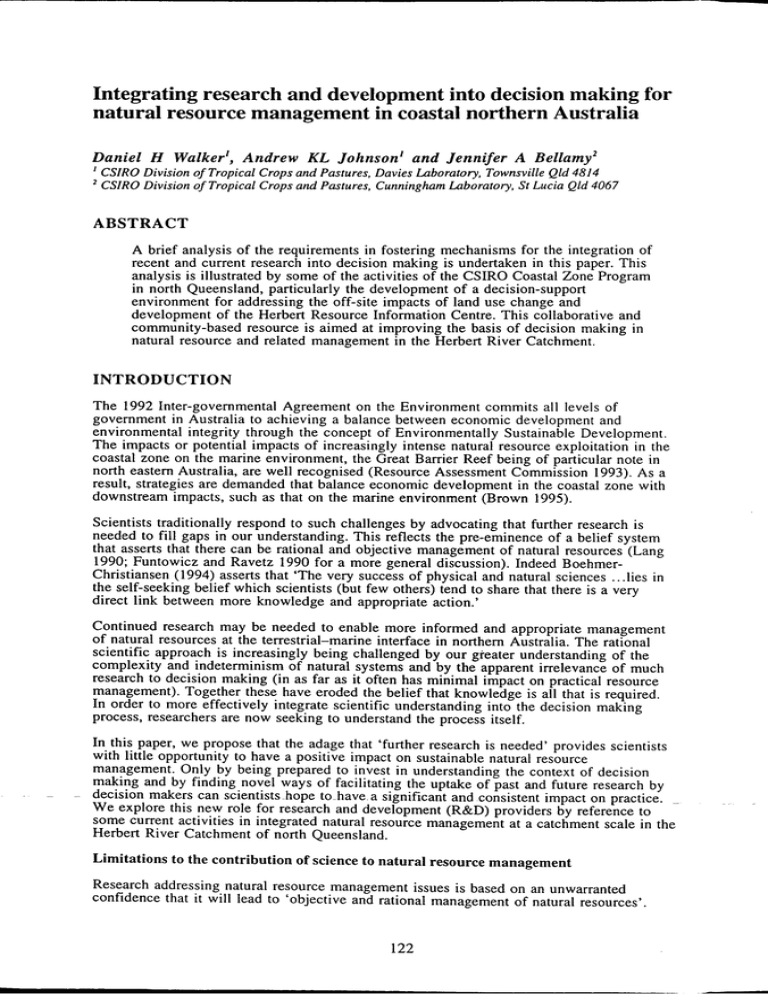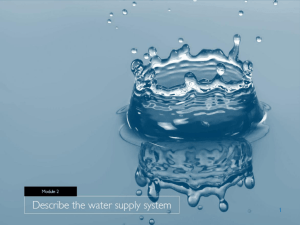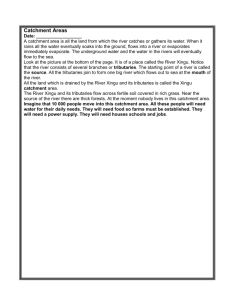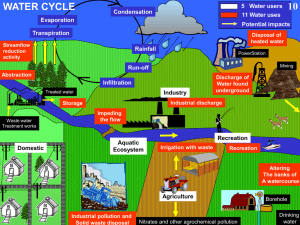Integrating research and development into decision making for
advertisement

Integrating research and development into decision making for
natural resource management in coastal northern Australia
Daniel H Walker !, Andrew KL Johnson I and Jennifer A B e l l a m y 2
1 CSIRO Division of Tropical Crops and Pastures, Davies Laboratory, Townsville Qld 4814
2 CSIRO Division of Tropical Crops and Pastures, Cunningham Laboratory, St Lucia Qld 4067
ABSTRACT
A brief analysis of the requirements in fostering mechanisms for the integration of
recent and current research into decision making is undertaken in this paper. This
analysis is illustrated by some of the activities of the CSIRO Coastal Zone Program
in north Queensland, particularly the development of a decision-support
environment for addressing the off-site impacts of land use change and
development of the Herbert Resource Information Centre. This collaborative and
community-based resource is aimed at improving the basis of decision making in
natural resource and related management in the Herbert River Catchment.
INTRODUCTION
The 1992 Inter-governmental Agreement on the Environment commits all levels of
government in Australia to achieving a balance between economic development and
environmental integrity through the concept of Environmentally Sustainable Development.
The impacts or potential impacts of increasingly intense natural resource exploitation in the
coastal zone on the marine environment, the Great Barrier Reef being of particular note in
north eastern Australia, are well recognised (Resource Assessment Commission 1993). As a
result, strategies are demanded that balance economic development in the coastal zone with
downstream impacts, such as that on the marine environment (Brown 1995).
Scientists traditionally respond to such challenges by advocating that further research is
needed to fill gaps in our understanding. This reflects the pre-eminence of a belief system
that asserts that there can be rational and objective management of natural resources (Lang
1990; Funtowicz and Ravetz 1990 for a more general discussion). Indeed BoehmerChristiansen (1994) asserts that 'The very success of physical and natural sciences ...lies in
the self-seeking belief which scientists (but few others) tend to share that there is a very
direct link between more knowledge and appropriate action.'
Continued research may be needed to enable more informed and appropriate management
of natural resources at the terrestrial-marine interface in northern Australia. The rational
scientific approach is increasingly being challenged by our greater understanding of the
complexity and indeterminism of natural systems and by the apparent irrelevance of much
research to decision making (in as far as it often has minimal impact on practical resource
management). Together these have eroded the belief that knowledge is all that is required.
In order to more effectively integrate scientific understanding into the decision making
process, researchers are now seeking to understand the process itself.
In this paper, we propose that the adage that 'further research is needed' provides scientists
with little opportunity to have a positive impact on sustainable natural resource
management. Only by being prepared to invest in understanding the context of decision
making and by finding novel ways of facilitating the uptake of past and future research by
decision makers can scientists hope to have. a significant and consistent impact on practice.
We explore this new role for research and development (R&D) providers by reference to
some current activities in integrated natural resource management at a catchment scale in the
Herbert River Catchment of north Queensland.
Limitations to the contribution of science to natural resource management
Research addressing natural resource management issues is based on an unwarranted
confidence that it will lead to 'objective and rational management of natural resources'.
122
This implies that there are demonstrably correct solutions to natural resource management
problems; that is that we can achieve decisions based on unanswerable and irrefutable logic.
This is naive, in that it does not recognise that natural resource management is inherently a
political process in which different needs and interests are balanced. Where policy is
presented as being based solely on scientific evidence, this is almost inevitably a politically
expedient 'fig leaf' for more complex motivations and compromises (BoehmerChristiansen 1994). Effective natural resource management can occur without formal
research but not without an effective political process.
Quite apart from the political nature of natural resource management, 'objective and
rational management' may often be unattainable. Science is itself a political process
(though highly institutionalised), being based on attaining consensus amongst peers with the
consensus achieved in ecology generally more speculative than in physical sciences.
Predicting processes at an ecosystem scale may simply be an intractable task since issues
may be so complex and indeterminate that predictive understanding may be practically, or
even theoretically, unattainable. Certainly, a strong case can be made that process-based
understanding of ecosystem behaviour in response to stresses can often only be weakly
predictive (Peters 1991). Catchment scale resource management deals with complex
ecological, social and economic interactions in a dynamic situation with long time-frames
and often considerable separation between cause and effect and the potential for irreversible
outcomes (e.g. Norton et al. 1996). As a result, uncertainty and ignorance need to be
managed and communicated so that they become recognised inputs to the decision making
process (Funtowicz and Ravetz 1990; Costanza et al. 1992; Dovers 1995).
In short, the traditional assumption that science can provide unambiguous answers becomes
hard to defend when applied to natural resource management. Given the uncertain and
complex nature of ecosystems, we have to accept that more scientific knowledge does not
necessarily lead to better answers at a scale and within a timeframe appropriate for action.
Maximising the contribution of science to decision making
While research rarely solves natural resource management problems, it clearly can
contribute to their solution. We argue that, in order to optimise this contribution, researchers
need to:
9 understand the context of decision making;
9 understand and seek to facilitate the processes of analysis and synthesis for natural
resource management; and
9 seek to facilitate the integration of research outputs into these processes.
Understanding the decision making context
The context of decision making encompasses legislative, economic, historical and social
considerations. Knowledge and data are the fuel for the decision making process in natural
resource management, but the same fuel can be placed in different engines to quite different
effect. A failure to appreciate context of application, the nature of the engine, is a recipe for
irrelevant research.
Northern Australia has a history of limited planning and control. Government planning and
management remains anathema to many rural residents, particularly in the north. So, while
effective natural resource management is agreed as being necessary, the process is politically
unacceptable. At the same time, centralised government resources are being constantly
reduced. In response to both these pressures, the State and Federal governments' preferred
direction for natural resource management in northern Australia is towards negotiated and
consensual management by multiple stakeholders and decision makers (Brown 1995).
Initiatives such as Property Management Planning, Landcare and the Integrated Catchment
Management (ICM) program in Queensland are prominent examples of this ethos.
The participants in these initiatives have become major clients for research in rural north
Queensland. However, in order to meet their needs, the processes themselves must be
understood. What is required in, for example, understanding ICM as a decision making
context?
123
In October 1991, an Integrated Catchment Management Strategy for Queensland was
released by the State Government. The Strategy is intended to provide a framework for
fostering cooperation and coordination between landholders and other resource users,
community groups and government agencies involved in the use and management of
natural resources. It is dependent on landholders, the community in general and
government having a sound understanding of the interactions between natural resources and
the need for a coordinated catchment-wide approach for addressing issues affecting these
resources.
To understand the implications of this initiative, we need to evaluate the process of
implementation of ICM: to identify social, economic and institutional factors that facilitate
or hinder this process, to evaluate the impacts in terms of attitude and behaviour and the
tractability and severity of resource use conflicts and, thereby assess the specific technical
and related information needs for effective ICM in a wet tropical environment. This
demands consideration of the resource use and social history of a catchment, the legislative
and institutional context of resource use, community and stakeholder attitudes and, of
course, the nature, availability, distribution and use of current knowledge about relevant
biophysical processes. A current multi-disciplinary project over five years is undertaking
precisely this type of evaluation in the Herbert catchment of north Queensland.
Understanding and facilitating analysis and synthesis in natural resource management
If research providers can be criticised for failing to understand the context of application,
they can also be criticised for failing to facilitate the uptake of existing knowledge. While
there is much research relevant to catchment scale natural resource management in northern
Australia that needs to be done, there is a lot that has been done already. This includes both
formal research results and the vastly greater pool of experience of landholders, natural
resource management professionals and the broader community. Much of this knowledge
is, for one reason or another, inaccessible to those involved in the natural resource
management decision making process. Research providers should be able to re-package it to
make it accessible, or provide the necessary tools to access and use it in its present form.
In 1995 a series of interviews were held with advisers from three state government agencies
and industry working in the Herbert catchment of north Queensland. These interviews
sought to characterise natural resource management tasks undertaken by these individuals at
that time (see Walker and Johnson 1996) and to obtain a broader perspective of the needs
they had and constraints under which they operated in providing advice on natural resource
management issues to decision makers such as local government. Some of the constraints
and opportunities that they identified are described below under five headings that
characterise steps in the process.
Step 1 - P r o b l e m f o r m u l a t i o n
The activities of the advisers interviewed involved comparatively little routine work, but
advisers were often faced with questions on quite new issues. As a result, one of the first
problems faced by many advisers in addressing a new situation was - what is important
here? What should I be considering? Addressing these questions demands a systems level
view of biophysical issues, which is rarely effectively provided by research agencies. The
challenge for research providers is how best to provide the information that advisers need to
decide the issues that merit consideration in any particular context.
Step 2 - Task analysis
Having decided on a range of issues that merit consideration, the adviser must decide how to
address them. This requires an understanding of the level of accuracy and precision
required, but also an understanding of the data resources and analytical tools available for
use in analysis, and the limitations associated with these resources. Where does this
information come from and wh O should provide it?
Step 3 - Data analysis
Data analysis may take a number of forms. In many instances experience may be enough.
In other instances accessing and interpreting data about a site may suffice. However, there
will be instances where informed advice demands a more sophisticated analysis. Researchers
can make a large contribution to the accessibility of data resources, both by expanding the
natural resource data that is available and by developing means of allowing potential users
to find and interpret those data effectively. When advisers need to perform structured
124
analyses, they are generally applying generic analytical tools that are research outputs to
their particular instance. Researchers are accomplished at providing generic tools but less so
when it comes to providing guidance in the application of those tools to site specific
contexts. For example, any analytical tool will be based on a set of assumptions. These may
be implicit or explicit but either way are often not effectively communicated to potential
users.
Step 4 - S y n t h e s i s
A response to a request for advice on a complex natural resource management issue will
often require the synthesis of a range of analyses and arguments. A typical issue here was
how best to integrate local knowledge and experience with more formal analyses of data,
how to interpret the former in terms of the latter or vice versa. Research advances in systems
perspectives on resource use are not easily accessible to practitioners.
Step 5 - Presentation
The politics of natural resource management, particularly where contentious, putpressure
on advisers for unambiguous answers. However, these will often not be available.
Appropriate presentation of what is available and what it means is, therefore, very important
(Funtowicz and Ravetz 1990). Advice must be accessible and defendable. It must be
presented at an appropriate levels of abstraction, for example predicting trends and
presenting scenarios, rather than providing precise but quite possibly incorrect predictions.
Uncertainties and assumptions must be clearly stated without undermining the advice. The
data/knowledge must be plausible - particularly where using predictions as evidence.
Given the above requirements, the task of the professional natural resource manager is
challenging. There are, however, many opportunities for research contributions. For
example, the above analysis has underpinned the development of an advanced decision
support environment for natural resource management called NRM Tools (Walker and
Johnson in press). The toolkit is designed to provide the flexibility of application demanded
by users (Walker and Johnson 1996) in combining and recombining analytical functionality
to meet the demands of particular tasks. As such, NRM Tools is a powerful environment in
which to package and deliver research outputs. NRM Tools provides a mechanism whereby
decision makers can make use of quantitative models. It also provides means of delivering
qualitative or semi-quantitative knowledge and guidelines produced by research by
developing knowledge-based systems (most familiar in the form of expert systems) that can
be integrated into decision-support tools. NRM Tools not only provides a means of making
this analytical functionality more readily available to users, it also provides means of
facilitating their use. In particular, modules are currently under development that s u p p o r t
problem formulation ('I've been asked to comment on this change in resource
management - what possible implications should I be considering?') and task analysis and
tool construction ('I want to assess the implications of this land use change on water quality
and flooding risks - what data and analytical tools do I have to help me do this?').
Facilitating the uptake of research outputs
Research initiatives such as the development of NRM Tools add value to biophysical
research in making it available to managers. However, this is only true where the
technologies upon which such outputs are based are themselves accessible. They may often
not be. Here again, there are opportunities for researchers.
The Herbert Resource Information Centre (the HRIC) was established because many such
decision makers in the Herbert River catchment did not have adequate access to basic
information about the catchment. The HRIC is a community-based and collaborative jointventure which integrates a large range of high quality data about the Herbert catchment into
a GIS (Geographic Information System). The partners to the HRIC are the Hinchinbrook
Shire Council, CSR (the sugar milling company in the catchment), the Herbert Productivity
Board, the Queensland Department of Natural Resources and CSIRO. Two Centre staff
manage the data sets and undertake advanced analyses as required. Much routine analysis is
undertaken directly by staff in the participating organisations.
As well as introducing GIS to the catchment, and thereby providing much more effective
access to the range of data available about the catchment than was previously available, the
HRIC provides both the technical requirements and ethos required for the use of NRM
125
Tools by managers within the catchment. CSIRO's involvement in this project has, therefore,
both been of benefit in establishing a resource that is useful in its own right and has fostered
a context for uptake of research outputs, in this case NRM Tools.
The HRIC provides a context in which data, scientific knowledge and method can be better
integrated into local political processes by local people. The collaborative nature of the
centre can be expected to have an impact on the flow of information and the course of
debate in the catchment.
CONCLUSIONS
The creation of new knowledge usually involves institutions that are different from those
concerned with its application and dissemination. However, what is clearly increasingly
required is that the former better understand the latter if they intend to justify their existence
in terms of impact on natural resource management rather than advancement of knowledge
p e r se. Boehmer-Christiansen (1994) identified seven ways that experts can further their
own interests in policy development. The first three of these are: emphasise uncertainty and
incompleteness of knowledge; emphasise complexity and difficulty; emphasise threats that
can be tackled with more science and technology. We would suggest that the reality of
natural resource management in the 1990s means that these strategies are a fast-track to
irrelevance. We suggest it is far better to invest effort in exploring techniques by which
scientific expertise can be transformed into information relevant to natural resource
management.
Science is often more comfortable in providing advice on what ought to be done and why,
rather than practical advice on how it might be achieved (Boehmer-Christiansen 1994).
Initiatives such as the NRM Tools and HRIC are designed to provide practitioners with
access to scientific resources which they can then apply to the 'how' problem. Our vision is
one in which data, knowledge and scientific judgements of that data/knowledge can all be
made available for integration into a negotiation process that attempts to deal with inherent
uncertainty. Therefore, there is a considerable focus on communication of the principles,
values and assumptions underlying analyses. Ideally initiatives such as NRM Tools and
HRIC should ultimately lead to co-design of research in which researchers and local
stakeholders interact to explore the extent to which applied science can make a contribution
to effective and sustainable natural resource management.
REFERENCES
Boehmer-Christiansen, S. 1994. Politics and environmental management. Journal of
Environmental Planning and Management 37(1): 69-85.
Brown, V.A. 1995. Turning the Tide: Integrated local area management for Australia's
Coastal Zone. DEST, Canberra.
Costanza, R., S.O. Funtowicz and J.R. Ravetz 1992. Assessing and communicating data
quality in policy-relevant research. Environmental Management 16(1): 121-131.
Dovers, S. 1995. Risk, uncertainty and ignorance: policy processes and institutional issues,
pp. 14-32. In T.W. Norton, T. Beer and S.R. Dovers (eds), Risk and Uncertainty in
Environmental Management. Proceedings of the 1995 Australian Academy of
Science Fenner Conference on the Environment, 13-16 November 1995, Canberra.
ANU Centre for Resource and Environmental Studies.
Funtowicz, S.O. and J.R. Ravetz 1990. Uncertainty and Quality in Science for Policy.
Kluwer Academic Publishers, The Netherlands.
Lang, R. (ed.) 1990. Integrated Approaches to Resource Planning and Management. Banff
Centre, School of Management. University of Calgary Press, Canada.
Norton, T., H. Nix and J. Williams 1995. Risk, uncertainty and cumulative environmental
change, pp. 33-43. In T.W. Norton, T. Beer and S.R. Dovers (eds), Risk and
Uncertainty in Environmental Management. Proceedings of the 1995 Australian
Academy of Science Fenner Conference on the Environment, 13-16 November 1995,
Canberra. ANU Centre for Resource and Environmental Studies..
Peters, R.H. 1991. A Critique for Ecology. Cambridge University Press, UK.
126
Resource Assessment Commission 1993. Integrated resource management in Australia. RAC
Coastal Zone Inquiry, Information Paper No. 6, March 1993. AGPS, Canberra.
Walker, D.H. and A.K.L. Johnson 1996. Delivering flexible decision support for
environmental management - a case study in integrated catchment management.
Australian Journal of Environmental Management 3(3): 145-208.
Walker, D.H. and A.K.L. Johnson (in press). NRM Tools: a flexible decision support
environment for integrated catchment management. Environmental Software.
127






